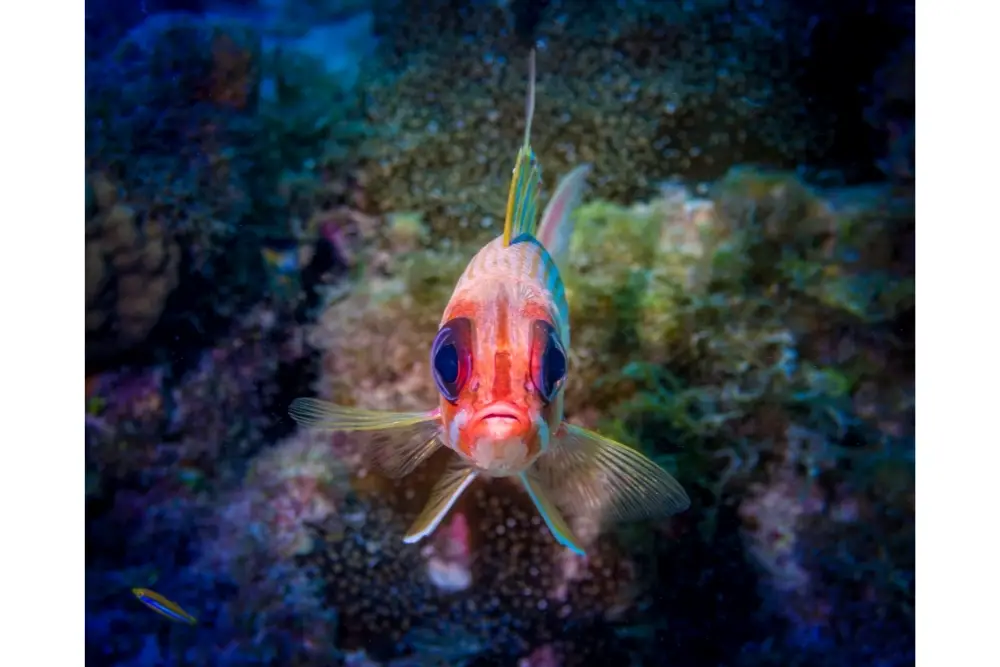Whether you’re thinking about goldfish in an aquarium or wild fish living in the depths of the ocean, one question that everybody has wondered at some point is “Are fish nocturnal?”.
Well, just like most other animals, there are some fish that are nocturnal and some that aren’t (these are known as diurnal fish). There are even some fish that live at such a great depth that they have no way of determining between night and day.
However, one thing that both nocturnal and diurnal fish have in common is that dawn and dusk are when they are most active.
When the sun comes up, diurnal fish will move from deeper waters where they have spent the night resting, into shallower waters where they can search for food in the emerging sunlight.
Nocturnal fish act in the opposite way. As the sun rises, they will make their journey towards deeper water where they will rest throughout the day.
And, as the sun begins to set, they’ll head back into shallower waters to search for food in the remaining hours of sunlight.

How do nocturnal fish find their way around?
Most nocturnal fish are nocturnal simply because they live in areas that are deprived of sunlight, such as catfish. Since they have never known anything other than low light levels, their bodies have adapted to be able to see more clearly at night.
Many nocturnal fish have smaller eyes, so their other senses are heightened to help guide them through the dark. This includes a higher sense of smell and taste.
Put simply, nocturnal fish ‘feel’ their way through the night. They can smell the chemical cues produced by their prey and this is what guides them where they need to go in order to get a meal.
This also means that nocturnal fish tend to swim much slower than diurnal fish, as they haven’t got the luxury of being able to see their prey.
How to set up a nocturnal aquarium
Building and maintaining a nocturnal aquarium is a fantastic choice of hobby for anybody who finds themselves in a position where they are awake throughout the night and sleeping during the day.
However, just like all aquariums, there are some things that you need to make sure you’ve included in your nocturnal aquarium.
The first thing you need to do is make sure you’ve created an environment that is full of hiding places. This can be caves, crevices, and plants that you’re nocturnal fish can shelter in during the day.
You also need to make sure that your aquarium has a light. This may seem counterintuitive since you’re creating a nocturnal aquarium, but light is essential for maintaining aquatic plants and corals.
You also need to provide the fish with a dim light that mimics dusk and moonlight.
Luckily, many aquariums come with the ability to switch between day and night lighting. This makes it much easier to keep both the fish and the plants in your aquarium happy and healthy.
A nocturnal aquarium should also be tall and wide. This will provide your fish with ample space to swim around at nighttime, while still giving you the space to create a lifelike aquascape full of hiding places.
Finally, you should make sure that your nocturnal aquarium has a heater and a thermometer. This will allow you to maintain the correct water temperature for your fish and the plants you’ve chosen.
Which fish are nocturnal?
If you’re thinking about setting up a nocturnal marine aquarium, it’s also important to know which species of fish you should add to it.
After all, there’s no point in building an aquarium that you can admire at night time only to find the fish you’ve chosen have all settled down for the evening!
To help you get this right, you can find some of the best nocturnal fish for marine tanks listed below.
1. Cardinalfish
These small, brightly-colored nocturnal fish are perfect for adding some vibrancy to a nocturnal aquarium.
Popular species include the Pajama Cardinalfish (Sphaeramia nematoptera), the Flame Cardinalfish (Apogon spp.), and the Five Lined Cardinalfish (Cheilodipterus quinquelineatus).
2. Squirrelfish
Squirrelfish like to live in small groups, and each fish can grow up to around 5-inches in length. They have a red boy with white, horizontal stripes that really make them stand out under the glow of a lunar aquarium light.
It’s worth noting, however, that their natural diet consists of smaller fish, so if you want to include squirrelfish in your nocturnal aquarium, it’s a good idea to make sure they are the smallest fish in the tank!
3. Soldierfish
With large, serrated scales and a vibrant red color, soldierfish make a beautiful addition to any nocturnal aquarium. Unlike a lot of nocturnal fish, they also have large, ovalur eyes, giving them even more interest.
Popular species of soldierfish for a home aquarium include the Scarlet Fin Soldierfish (Sargocentron sp.) and the Big Eye Black Bar Soldierfish (Myripristis sp.).
4. Scorpionfish
If you’re looking for the weird and wonderful, a scorpionfish fits the brief perfectly! However, extreme care must be taken when including a scorpionfish as a member of your nocturn aquarium as these are one of the world’s most venomous creatures.
Their super-sharp spines are covered with a venomous mucus, and they prey on other fish by blending in perfectly with their surroundings. If you’re thinking of getting a scorpionfish, you may well want to consider making it the only fish in your aquarium.
5. Eels
While eels aren’t an obvious choice for a nocturnal aquarium, they certainly make unique and interesting additions to the tank.
Popular species include the Ghost Eel (Pseudechidna brummer) which is almost entirely white and can grow up to 40-inches in length. One thing to consider with all eels, however, is that they can be semi-aggressive towards other fish in the aquarium.






